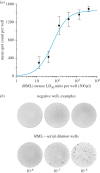A systematic investigation of production of synthetic prions from recombinant prion protein
- PMID: 26631378
- PMCID: PMC4703057
- DOI: 10.1098/rsob.150165
A systematic investigation of production of synthetic prions from recombinant prion protein
Abstract
According to the protein-only hypothesis, infectious mammalian prions, which exist as distinct strains with discrete biological properties, consist of multichain assemblies of misfolded cellular prion protein (PrP). A critical test would be to produce prion strains synthetically from defined components. Crucially, high-titre 'synthetic' prions could then be used to determine the structural basis of infectivity and strain diversity at the atomic level. While there have been multiple reports of production of prions from bacterially expressed recombinant PrP using various methods, systematic production of high-titre material in a form suitable for structural analysis remains a key goal. Here, we report a novel high-throughput strategy for exploring a matrix of conditions, additives and potential cofactors that might generate high-titre prions from recombinant mouse PrP, with screening for infectivity using a sensitive automated cell-based bioassay. Overall, approximately 20,000 unique conditions were examined. While some resulted in apparently infected cell cultures, this was transient and not reproducible. We also adapted published methods that reported production of synthetic prions from recombinant hamster PrP, but again did not find evidence of significant infectious titre when using recombinant mouse PrP as substrate. Collectively, our findings are consistent with the formation of prion infectivity from recombinant mouse PrP being a rare stochastic event and we conclude that systematic generation of prions from recombinant PrP may only become possible once the detailed structure of authentic ex vivo prions is solved.
Keywords: prion; prion amyloid; prion disease; prion protein; synthetic prions.
© 2015 The Authors.
Figures



References
-
- Prusiner SB. 1998. Prions. Proc. Natl Acad. Sci. USA 95, 13 363–13 383. (doi:10.1073/pnas.95.23.13363) - DOI - PMC - PubMed
-
- Collinge J. 2001. Prion diseases of humans and animals: their causes and molecular basis. Annu. Rev. Neurosci. 24, 519–550. (doi:10.1146/annurev.neuro.24.1.519) - DOI - PubMed
-
- Collinge J, Clarke A. 2007. A general model of prion strains and their pathogenicity. Science 318, 930–936. (doi:10.1126/science.1138718) - DOI - PubMed
-
- Jucker M, Walker LC. 2013. Self-propagation of pathogenic protein aggregates in neurodegenerative diseases. Nature 501, 45–51. (doi:10.1038/nature12481) - DOI - PMC - PubMed
-
- Jackson GS, et al. 1999. Reversible conversion of monomeric human prion protein between native and fibrilogenic conformations. Science 283, 1935–1937. (doi:10.1126/science.283.5409.1935) - DOI - PubMed
Publication types
MeSH terms
Substances
Grants and funding
LinkOut - more resources
Full Text Sources
Other Literature Sources
Research Materials
